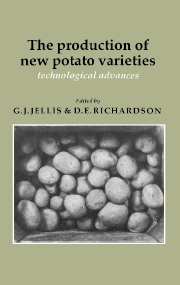Book contents
- Frontmatter
- Contents
- List of contributors
- Preface
- Editors' note and acknowledgements
- Introduction
- The development of potato varieties in Europe
- Genetic Resources
- Breeding Strategies
- Selection and Screening Methods
- The efficiency of early generation selection
- Problems associated with early generation selection of potato clones in West Siberia
- Influence of weight of seed tubers on selection of first year clones: preliminary results
- A joint cyst nematode/late blight test for early generation screening of potato clones
- Screening for resistance to diseases in a potato breeding programme
- Breeding for resistance to potato viruses with special reference to cDNA probes
- Screening for resistance to diseases and pests
- Breeding for resistance to and tolerance of potato cyst nematode
- Breeding multi-resistant potato germplasm
- Resistance to storage diseases in breeding stocks
- Phytophthora research at the Foundation for Agricultural Plant Breeding (SVP)/ The Netherlands
- Effect of time interval between inoculation and assessment on relative content of potato virus YN in leaves of potato plants
- Selection and evaluation of potatoes for improved tolerance of environmental stresses
- Variety Assessment
- Semi-conventional Breeding Methods
- True Potato Seed
- Unconventional Breeding Methods
- Commentary
- Index
A joint cyst nematode/late blight test for early generation screening of potato clones
Published online by Cambridge University Press: 05 March 2012
- Frontmatter
- Contents
- List of contributors
- Preface
- Editors' note and acknowledgements
- Introduction
- The development of potato varieties in Europe
- Genetic Resources
- Breeding Strategies
- Selection and Screening Methods
- The efficiency of early generation selection
- Problems associated with early generation selection of potato clones in West Siberia
- Influence of weight of seed tubers on selection of first year clones: preliminary results
- A joint cyst nematode/late blight test for early generation screening of potato clones
- Screening for resistance to diseases in a potato breeding programme
- Breeding for resistance to potato viruses with special reference to cDNA probes
- Screening for resistance to diseases and pests
- Breeding for resistance to and tolerance of potato cyst nematode
- Breeding multi-resistant potato germplasm
- Resistance to storage diseases in breeding stocks
- Phytophthora research at the Foundation for Agricultural Plant Breeding (SVP)/ The Netherlands
- Effect of time interval between inoculation and assessment on relative content of potato virus YN in leaves of potato plants
- Selection and evaluation of potatoes for improved tolerance of environmental stresses
- Variety Assessment
- Semi-conventional Breeding Methods
- True Potato Seed
- Unconventional Breeding Methods
- Commentary
- Index
Summary
This paper describes a technique for screening breeding material in the first clonal year for resistance to Globodera rostochiensis, G. pallida and Phytophthora infestans. Seedlings were grown in pots in an aphid-proof glasshouse and after harvest, when tubers with poor colours, extremely long stolons or very poor shape were rejected, tubers were stored at 5°C until dormancy had broken. Tubers were removed from store at weekly intervals and kept at room temperature to induce sprouting. One small tuber was planted on the surface of 100g of compost at 30 % water content in each closed transparent plastic container, as described by Phillips et al.(1980). The inoculum used was a suspension of equal numbers of eggs/larvae of both G. rostochiensis Rol and G. pallida Pa2–3 collected from beds where they had been maintained on the appropriate differential host variety. The containers were kept in a dark store room (15 to 20°C) for 6 to 7 weeks while the cysts were forming. Recording commenced when the majority of the cysts of G. rostochiensis were yellow and G. pallida were white. A few mature cysts were brown and hence not assignable to species, while some G. rostochiensis cysts were still white and wrongly attributed to G. pallida, but as only clones with dual resistance were selected this was not of practical importance.
- Type
- Chapter
- Information
- The Production of New Potato VarietiesTechnological Advances, pp. 81 - 83Publisher: Cambridge University PressPrint publication year: 1987
- 1
- Cited by

